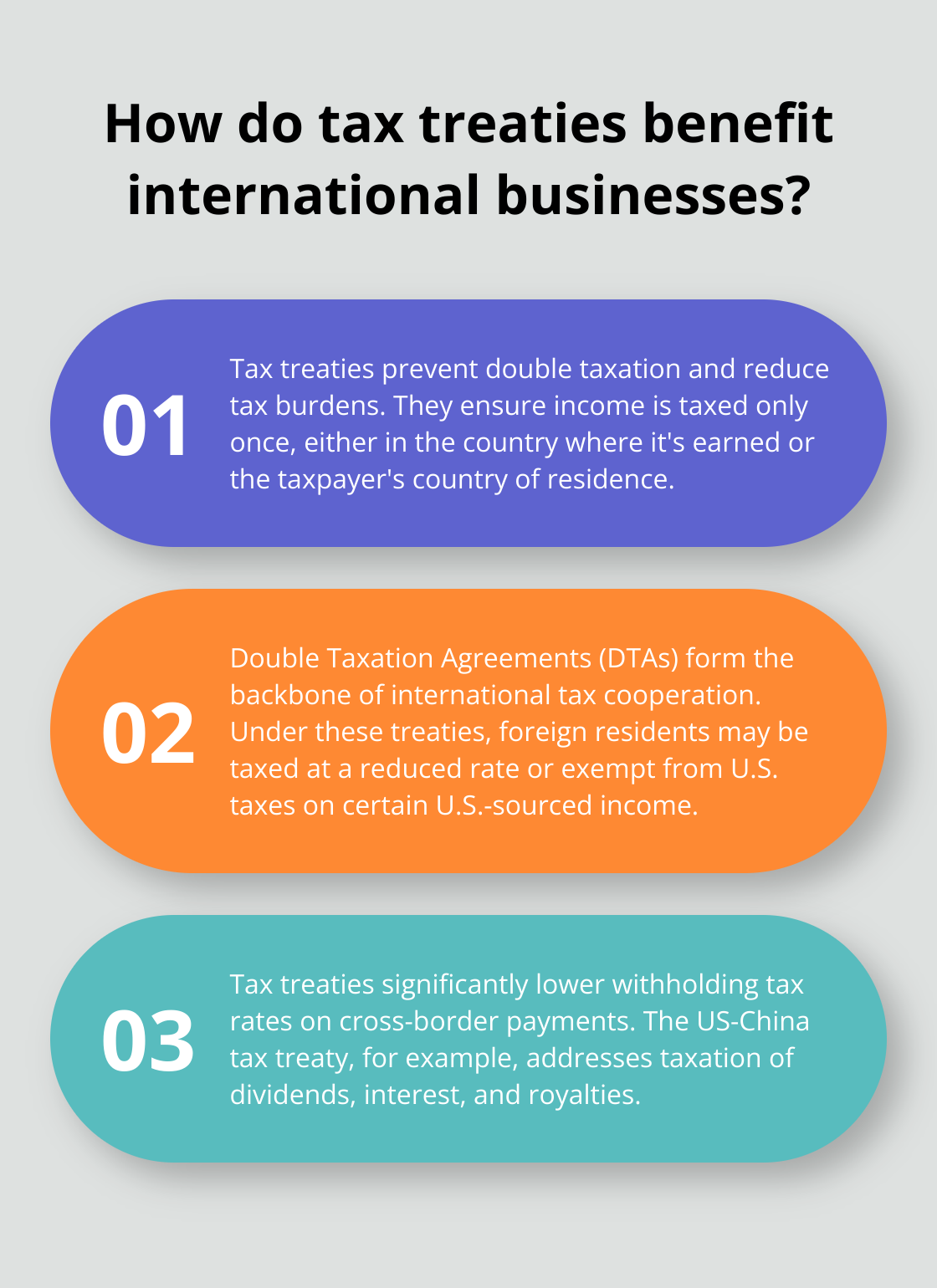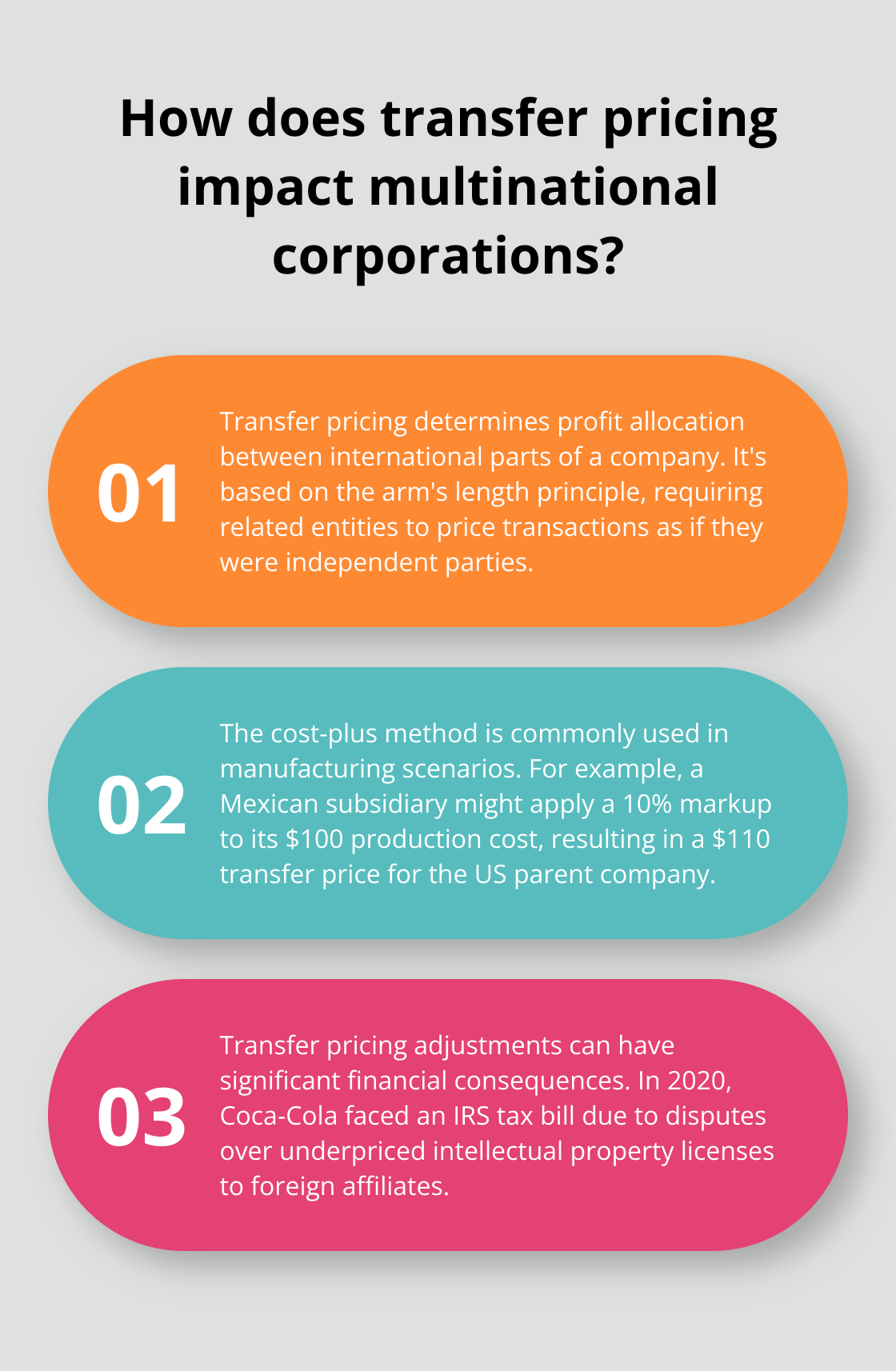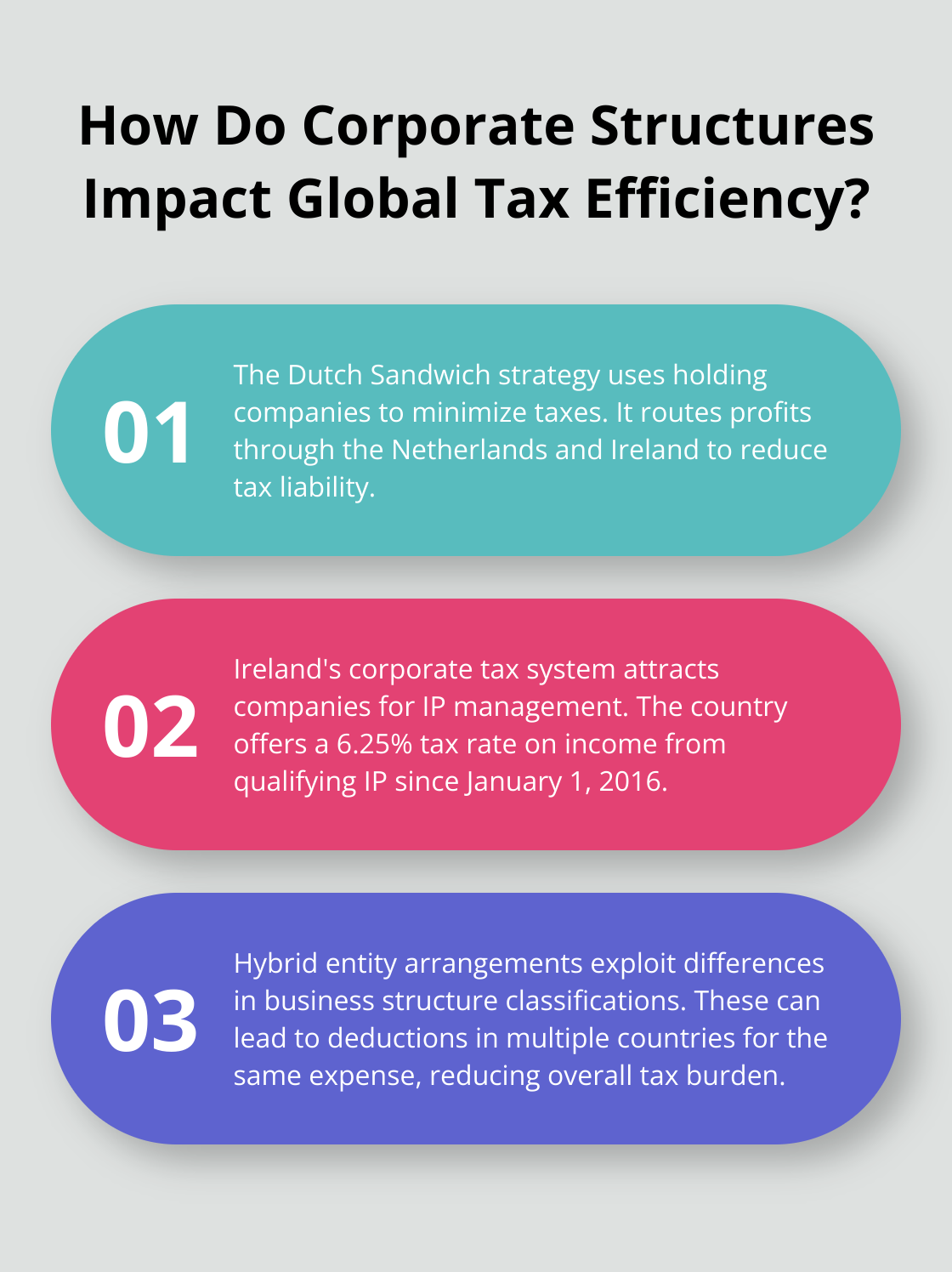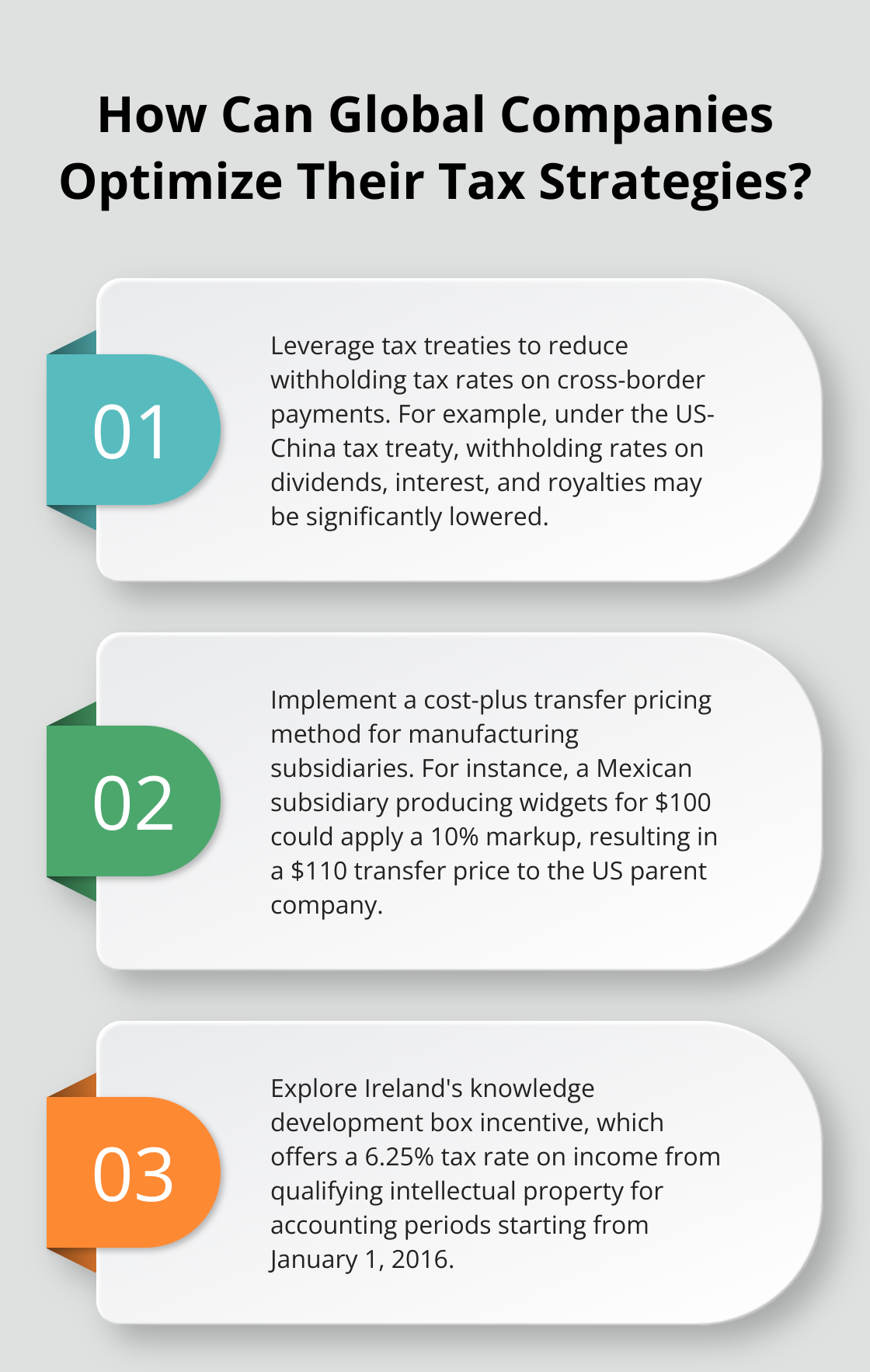
International tax planning can be a complex maze for businesses operating across borders. At Sager CPA, we’ve seen firsthand how real-world examples can illuminate the path to effective strategies.
This blog post will explore international tax planning examples, from leveraging tax treaties to optimizing corporate structures. We’ll dive into practical case studies that demonstrate how companies navigate the global tax landscape while staying compliant with ever-changing regulations.
Tax treaties serve as powerful tools for businesses operating across borders. These agreements between countries prevent double taxation and reduce tax burdens for companies and individuals. Many clients experience significant tax savings and smoother cross-border operations due to these treaties.
Double Taxation Agreements (DTAs) form the backbone of international tax cooperation. These treaties ensure that income faces taxation only once, either in the country where it’s earned or in the taxpayer’s country of residence. Under these treaties, residents of foreign countries are taxed at a reduced rate, or are exempt from U.S. taxes on certain items of income they receive from U.S. sources.
One of the most tangible benefits of tax treaties is the reduction of withholding tax rates. Without a treaty, countries often impose high withholding taxes on payments made to foreign entities. However, treaties can significantly lower these rates. For instance, the US-China tax treaty addresses the taxation of dividends, interest, and royalties in specific articles of the agreement.
The US-Canada tax treaty offers a prime example of how these agreements can benefit individuals. Under this treaty, Canadian residents working temporarily in the US can avoid US tax liability if they meet specific criteria. For instance, if a Canadian software developer works in the US for less than 183 days in a year and their salary comes from a Canadian employer, they may qualify for exemption from US income tax.

This provision has changed the game for many professionals. It allows Canadian workers to maximize their tax benefits while staying compliant with both US and Canadian tax laws.
Tax treaties offer complex benefits that are not always straightforward. Working with experienced international tax professionals can help you navigate these agreements and maximize their advantages for your specific situation. These experts can guide you through the intricacies of treaty provisions, ensuring you don’t miss out on potential tax savings.
As we move forward, we’ll explore another critical aspect of international tax planning: transfer pricing strategies. These strategies play a vital role in how multinational companies allocate profits and manage their global tax liabilities.
Transfer pricing is a critical aspect of international tax planning that affects multinational corporations’ bottom lines. It determines how profits are allocated between different parts of a company operating across international borders.
The cornerstone of transfer pricing is the arm’s length principle. This principle requires transactions between related entities to be priced as if they were between independent parties. In practice, a subsidiary in one country should charge its parent company or sister company in another country the same price for goods or services that it would charge an unrelated company.

For instance, if a US-based tech company sells software licenses to its German subsidiary, the price should be comparable to what it would charge an unrelated German company for the same licenses. This principle aims to prevent profit shifting to lower-tax jurisdictions.
One common transfer pricing method is the cost-plus approach, often used in manufacturing scenarios. Under this method, a manufacturer adds a markup to its costs to determine the transfer price.
Consider this example: A US-based company has a manufacturing subsidiary in Mexico. The Mexican subsidiary’s costs for producing a widget are $100. They apply a 10% markup, resulting in a transfer price of $110 when selling to the US parent company. This markup should be comparable to what independent manufacturers in Mexico typically charge.
Transfer pricing adjustments can have significant financial implications. In 2020, Coca-Cola faced a tax bill from the IRS due to transfer pricing disputes. The IRS argued that Coca-Cola had underpriced the value of its intellectual property licensed to foreign affiliates, effectively shifting profits to lower-tax jurisdictions.
This case highlights the importance of robust transfer pricing documentation and policies. Companies must prepare to defend their pricing strategies to tax authorities. Failure to do so can result in hefty penalties, double taxation, and reputational damage.
Navigating the complexities of transfer pricing requires expert guidance. Companies should work with experienced tax professionals who understand the nuances of international tax law and can help develop compliant and effective transfer pricing strategies. These experts can assist in creating documentation, conducting benchmarking studies, and defending pricing policies during tax audits.
As we move forward, we’ll explore another crucial aspect of international tax planning: corporate structure optimization. This strategy can significantly impact a company’s global tax position and overall financial performance.
Corporate structure optimization serves as a powerful tool in international tax planning. Strategic structuring can significantly impact a company’s global tax position and financial performance. Let’s explore some real-world examples of how businesses leverage corporate structures for tax efficiency.
The Dutch Sandwich, a tax strategy used by multinational corporations, illustrates the power of holding company structures. This strategy involves routing profits through the Netherlands to take advantage of its favorable tax laws.

A US tech company might set up a Dutch holding company that owns an Irish subsidiary. The Irish company licenses intellectual property to other subsidiaries worldwide. Profits from these licenses flow to Ireland, where they face taxation at a low rate. The Irish company then pays royalties to the Dutch holding company, which faces minimal withholding tax due to EU regulations. Finally, the Dutch company can transfer the money to a tax haven with little to no additional tax.
While this strategy has proven effective for many companies, recent changes in international tax laws have made it less viable. The OECD’s BEPS project has led to increased scrutiny of such arrangements, as these practices can undermine the fairness and integrity of tax systems.
Ireland’s corporate tax system has long attracted companies for intellectual property (IP) management. Until recently, companies could use the Double Irish arrangement to minimize taxes on IP-related income.
Google’s use of this structure provides a well-known example. The company licensed its IP to an Irish-registered company that was tax resident in Bermuda. This company then sublicensed the IP to a second Irish company that collected revenues from non-US markets. The result was a significant reduction in Google’s effective tax rate on its non-US profits.
Ireland has phased out the Double Irish structure due to international pressure. Now, companies explore new strategies, such as Ireland’s knowledge development box, which offers a 6.25% tax rate on income from qualifying IP. This incentive applies for accounting periods commencing on or after January 1, 2016.
Hybrid entity arrangements take advantage of differences in how countries classify certain business structures for tax purposes. These arrangements can lead to significant tax savings but also carry risks.
A US company might set up a subsidiary in Luxembourg that’s treated as a corporation for Luxembourg tax purposes but as a partnership for US tax purposes. This can result in deductions in both countries for the same expense (effectively reducing the overall tax burden).
However, tax authorities increasingly target these arrangements. The OECD’s BEPS Action 2 specifically addresses hybrid mismatches, and many countries have implemented rules to neutralize their tax effects.
Navigating the complexities of corporate structures requires expert guidance. Companies should work with experienced tax professionals who understand the nuances of international tax law and can help develop compliant and effective strategies. These experts can assist in creating documentation, conducting benchmarking studies, and defending structural decisions during tax audits.
At Sager CPA, we help our clients navigate these complex waters, ensuring they benefit from efficient corporate structures while staying compliant with evolving international tax laws. We believe in creating sustainable tax strategies that can withstand scrutiny from tax authorities worldwide.
International tax planning examples demonstrate the complexity of managing global tax liabilities. Companies must balance tax efficiency with compliance to ensure their strategies align with current regulations. The OECD’s BEPS project and similar initiatives continue to reshape the global tax environment, making it essential for businesses to stay informed and adaptable.
Sager CPA understands the intricacies of international tax planning. Our team of experts helps clients navigate these complex waters, ensuring they benefit from efficient tax strategies while maintaining compliance with evolving international tax laws. We offer comprehensive tax planning services to reduce liabilities, coupled with strategic business advisory to foster long-term financial stability and growth.

Effective international tax planning requires a nuanced understanding of global tax systems, attention to detail, and the ability to anticipate regulatory changes. Partnering with experienced professionals allows businesses to develop sustainable tax strategies that optimize their global tax position while mitigating risks (without resorting to aggressive tax avoidance).




Privacy Policy | Terms and Conditions | Powered by Cajabra
At Sager CPAs & Advisors, we understand that you want a partner and an advocate who will provide you with proactive solutions and ideas.
The problem is you may feel uncertain, overwhelmed, or disorganized about the future of your business or wealth accumulation.
We believe that even the most successful business owners can benefit from professional financial advice and guidance, and everyone deserves to understand their financial situation.
Understanding finances and running a successful business takes time, education, and sometimes the help of professionals. It’s okay not to know everything from the start.
This is why we are passionate about taking time with our clients year round to listen, work through solutions, and provide proactive guidance so that you feel heard, valued, and understood by a team of experts who are invested in your success.
Here’s how we do it:
Schedule a consultation today. And, in the meantime, download our free guide, “5 Conversations You Should Be Having With Your CPA” to understand how tax planning and business strategy both save and make you money.